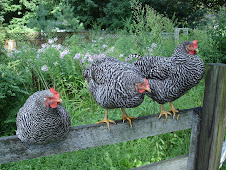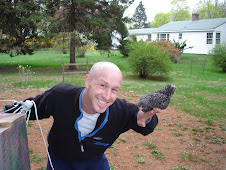This year we had the garden tilled and fenced as soon as the ground could be worked. And this week we put together a garden plan so that we know exactly where everything is going before it goes there. Here's the plan (although it is still flexible as we figure things out) -
 Our beds are 4' wide, with 2' wide paths between beds. (I can't tell you how excited I am to have organized beds.) So plan and tape measure in hand, Joe and I spent last weekend laying out most of the beds and paths. It's soooo pretty -
Our beds are 4' wide, with 2' wide paths between beds. (I can't tell you how excited I am to have organized beds.) So plan and tape measure in hand, Joe and I spent last weekend laying out most of the beds and paths. It's soooo pretty - Our peas are in the very first bed, doing really well. After they're harvested they'll be pulled up and replaced with tomatoes.
Our peas are in the very first bed, doing really well. After they're harvested they'll be pulled up and replaced with tomatoes. With everything in place, this weekend it was time for some serious planting! All the cool weather plants that were started from seed indoors are ready for the open ground this time of year - that includes broccoli, cabbage, brussels sprouts, onions, and swiss chard. It was also time to direct seed beets, carrots, and mesclun greens. Lucky for me, Friday was the most beautiful day we've had yet this spring - 70 degrees and sunny! So I took the day off from work (sooo worth it Lida), and spent the day filling the garden in, following our pretty plan. Very satisfying. This below is the swiss chard - 52 plants - we're doing a lot of it because they're an easy vegetable to cook fast, you can eat from the plants all season, and we can freeze them.
With everything in place, this weekend it was time for some serious planting! All the cool weather plants that were started from seed indoors are ready for the open ground this time of year - that includes broccoli, cabbage, brussels sprouts, onions, and swiss chard. It was also time to direct seed beets, carrots, and mesclun greens. Lucky for me, Friday was the most beautiful day we've had yet this spring - 70 degrees and sunny! So I took the day off from work (sooo worth it Lida), and spent the day filling the garden in, following our pretty plan. Very satisfying. This below is the swiss chard - 52 plants - we're doing a lot of it because they're an easy vegetable to cook fast, you can eat from the plants all season, and we can freeze them. And here's the row of broccoli in the ground - they're still pretty small, but they should be just fine in the ground -
And here's the row of broccoli in the ground - they're still pretty small, but they should be just fine in the ground -  Today I went back over to the garden to mulch all the seedlings in. Although mulching is not at all my favorite garden activity, it is always worth it. It is the reason we don't spend out entire lives weeding the garden in the summer. It also keeps the moisture levels and temperatures even, and adds organic matter to the soil over time. It's just a good idea. Plus, we have quite a supply since my mother has had a few trees cut down over the last couple years -
Today I went back over to the garden to mulch all the seedlings in. Although mulching is not at all my favorite garden activity, it is always worth it. It is the reason we don't spend out entire lives weeding the garden in the summer. It also keeps the moisture levels and temperatures even, and adds organic matter to the soil over time. It's just a good idea. Plus, we have quite a supply since my mother has had a few trees cut down over the last couple years -


.JPG) The next morning Joe made an amazing breakfast of eggs, ramps, onion grass, and peppers. Now if this doesn't make you want to cook, I don't know what will -
The next morning Joe made an amazing breakfast of eggs, ramps, onion grass, and peppers. Now if this doesn't make you want to cook, I don't know what will -


























